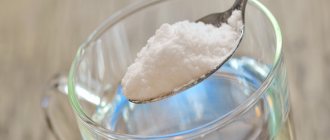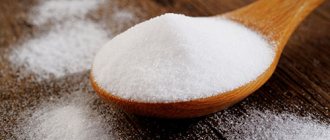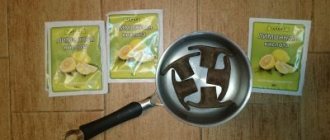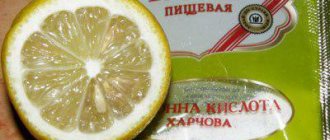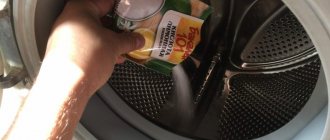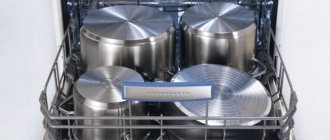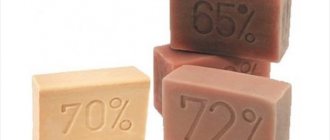How is citric acid harmful to the body?
Increased dosage of citric acid
can damage tooth enamel and contribute to the appearance of caries... If it gets into the eyes, such a solution will cause severe burning of the eye mucosa and skin irritation. It should be remembered that overdoing is not justified. Moderation is good in everything!
Interesting materials:
In what document is serfdom legally formalized? In which document viewing mode are headers and footers displayed? What legal document establishes the general responsibilities of military personnel? Adobe illustrator how to change color? How to restore hair color? What happens if you mix orange and blue? What happens if you mix blue and purple? What happens if you mix green and yellow? What happens if you mix yellow and red? What goes with Burgundy?
Cooking
Citric acid helps maintain the attractive appearance of dishes, protects baked goods from mold, replaces baking powder, is used for pickling vegetables, plays the role of a preservative, and prevents jam from becoming sugary.
© Depositphotos
It is quite possible to replace lemon juice with diluted acid from a pack. Especially if the dish is subjected to heat treatment. With strong heating, beneficial substances will still evaporate from the juice. Such a replacement will not affect the taste at all, but, unfortunately, there will be no lemon smell.
As you can see, citric acid is a universal remedy, all the uses of which are almost impossible to list. Our editors are absolutely sure of one thing: you will definitely find a suitable use for it in everyday life.
LiveInternetLiveInternet
..
[url]https://www.liveinternet.ru/users/5941075/post411983038[ /url] /> How to dilute vinegar essence? (to get vinegar)
How to dilute vinegar from 70% vinegar essence:
9% vinegar, you need to take one part of the essence and add seven parts of water (1 tablespoon of essence and 7 tablespoons of water)
6% vinegar - add 11 parts of water to one part of essence (1 tablespoon of essence and 11 tablespoons of water)
5% vinegar - add 13 parts water to one part essence (1 tablespoon essence and 13 tablespoons water)
4% vinegar - add 17 parts of water to one part of essence (1 tablespoon of essence and 17 tablespoons of water)
3% vinegar - add 23 parts water to one part essence (1 tablespoon essence and 23 tablespoons water)
So, if you need 1 tablespoon of 70% vinegar essence, but you only have 5% vinegar, and its concentration is 13 times less, then you need to add 13 tablespoons of 5% vinegar.
Another point to consider is that if the recipe says 1 tablespoon of vinegar essence 70%, and you replace the essence with vinegar in the required proportion, then take not 1 liter of water, but several tablespoons less. That is, 5% vinegar 7 tablespoons and MINUS 13 tablespoons of water.
If you need to add 1 tablespoon of 70% vinegar essence, and you only have 9% vinegar, then you need to add 7 tablespoons of 9% vinegar.
Table vinegar (9%) can be replaced with apple cider vinegar.
But you need to understand that apple cider vinegar is sold at 5%, that is, to use it instead of 9% vinegar, you will need 2 times more apple cider vinegar. Instead of 1 tablespoon of 9% vinegar, take 2 tablespoons of apple cider vinegar.
Apple cider vinegar, grape (wine), rice vinegar, balsamic vinegar and others are most often used NOT for canning, but for dishes (borscht, salads, dressings) or marinating meat and fish. Since they still have their own specific taste, introduce them into your family’s diet carefully, because as you know, we are often conservative in our tastes, especially children.
You need to be even more careful if someone in the family has gastritis, ulcers or colitis, as well as
How to use citric acid for canning.
Most often in recipes you can find 2 tablespoons of bottled lemon juice or 1/2 teaspoon of lemon powder per 1 liter of water or for ready-made canned food per liter jar. For a half-liter jar (for example, tomato juice), you will need 1 tablespoon of lemon juice from a bottle or 1/4 teaspoon of dry lemon powder.
Please note that bottled lemon juice and freshly squeezed lemon juice are not the same thing. And to dress the salad, instead of one tablespoon of 6% vinegar, you will need two tablespoons of freshly squeezed lemon juice.
How to dilute dry citric acid?
If we need to dilute citric acid instead of vinegar, which is written in the recipe, then use our instructions. We indicated the percentage of vinegar and the amount of citric acid (dry).
Dilute citric acid crystals with water in the following proportion:
1 tablespoon of dry citric acid per 2 tablespoons of water. You will get a substitute for 70% vinegar essence. 1 teaspoon of dry citric acid per 14 tablespoons of water. You will have a substitute for 9% vinegar.
Food additive E330 is citric acid, produced in accordance with GOST 53040-2008 (old GOST 3652-69). By the way, citric acid is safe for the human body and does not irritate the mucous membranes of the respiratory and digestive tract.
Also in the “Household Economics” section Vinegar, citric acid - how to dilute, how to use Fish without small bones How to save a dish if... Correcting failures in the kitchen Cutlets, meatballs, meatballs, meatballs How to get rid of mold in the bathroom, on the walls? How to cook, how to freeze corn? Manual and electric vegetable cutters - Review
Vinegar, citric acid - how to dilute, how to use
Pros and cons of processing
Cleaning the oven with any means has its advantages and disadvantages. The use of lemon and citric acid is no exception. Among the advantageous characteristics, one cannot fail to note such a fact as the removal of unpleasant odors. In addition, the treated surfaces acquire their original shine.
| Positive sides | Negative nuances |
| Naturalness of the product | Duration by time |
| Health safety | Several stages of work |
| Efficiency of the procedure | Airing from 3 to 4 hours |
| Ease of use | |
| Economical |
Other lemon substitutes
Citric acid is not the only substitute for lemon. If you don’t have either one or the other at hand, you can successfully use:
- sour berries (red currants, lingonberries, cranberries);
- sorrel;
- oranges and tangerines;
- pomegranate, cherry, cranberry, apple, grape juice without sugar;
- table, apple or wine vinegar;
- lemon pepper (when cooking fish).
Natural substitutes are rich in bioactive substances and are beneficial for health. Most often, instead of lemon in cooking, 9% table vinegar is used: 4 teaspoons replace the juice of 1 lemon or 1 teaspoon of lemon juice.
So, can you replace lemon with citric acid? In cooking, definitely yes. Both components add sourness, make meat and fish juicy, and prevent sweet creams and jam from crystallizing. When replacing, be guided by the above proportions and taste the solution to get the desired percentage of acidity.
What amount of citric acid in grams is required to replace one lemon?
How much water is needed to dilute citric acid?
How to measure citric acid in grams with a teaspoon?
Approximately the recipe calls for one lemon, that is, if I dilute 1/4 teaspoon of citric acid in 100 grams of water, is that normal or too much?
When solving the problem of replacing a living lemon with citric acid, which sometimes has to be done, we must take into account that lemons are different in size, that they have different skin thicknesses (that is, the contents themselves may be a little more for thin-skinned lemons and a little less for lemons with thick peel), according to the degree of ripeness, which means that lemons also vary in acidity. Therefore, you can speak on average or specify the characteristics of these citrus fruits.
We also know that lemons contain citric, malic and ascorbic acids. But the specific gravity of their totality in different lemons again varies - from four to eight percent. These numbers are cited in many sources.
Therefore, we will calculate on average.
But even here we will encounter discrepancies in the data. For example, there is such a scheme for replacing lemon with citric acid:
Another source gives the following information on the same replacement (more on that here):
This means that instead of lemon you can take from six to ten grams of citric acid. So on average it turns out like this:
6 + 10 = 16 : 2 = 8.
We again reach a value of eight grams of crystalline citric acid in one teaspoon.
It should still be diluted with water
And try to see if you get “lemon juice”.
But tea spoons are also different, with different capacities). In general, you see, everything is conditional, everything is approximately. And each housewife has already gained her own experience on how to replace lemons and how to dilute citric acid with water.
Lemon is a very popular fruit, used not only for culinary purposes, but also in medicine and cosmetology. But it is not always at hand. Therefore, we will tell you how to replace lemon juice.
Lemon juice can be replaced with citric acid. Moreover, it is always at hand, does not deteriorate, does not erode, and it is easier to obtain the desired concentration from it. For example:
Your Answer:
If you want to add a comment to a question or check with its author for details, do not
use this form and click “Clarify/discuss the question” under the question text!
Single profile MediaFort
Register
What does registration give?
By registering on Povarenka, you can:
- add your own recipes;
- participate in ongoing competitions with many valuable prizes;
- save your favorite recipes to your “Cookbook”;
- ask cooking questions to recipe authors (and get answers!);
- communicate with other cooks on the forum.
How to dilute vinegar essence? (to get vinegar)
How to dilute vinegar from 70% vinegar essence:
9% vinegar , you need to take one part of the essence and add seven parts of water (1 tablespoon of essence and 7 tablespoons of water)
6% vinegar - add 11 parts of water to one part of essence (1 tablespoon of essence and 11 tablespoons of water)
5% vinegar - add 13 parts water to one part essence (1 tablespoon essence and 13 tablespoons water)
4% vinegar - add 17 parts of water to one part of essence (1 tablespoon of essence and 17 tablespoons of water)
3% vinegar - add 23 parts water to one part essence (1 tablespoon essence and 23 tablespoons water)
So, if you need 1 tablespoon of 70% vinegar essence, but you only have 5% vinegar, and its concentration is 13 times less, then you need to add 13 tablespoons of 5% vinegar.
Another point to consider is that if the recipe says 1 tablespoon of vinegar essence 70%, and you replace the essence with vinegar in the required proportion, then take not 1 liter of water, but several tablespoons less. That is, 5% vinegar 7 tablespoons and MINUS 13 tablespoons of water.
If you need to add 1 tablespoon of 70% vinegar essence, and you only have 9% vinegar, then you need to add 7 tablespoons of 9% vinegar.
When performing sugaring
Not everyone has the opportunity to visit beauty salons. Therefore, many women strive to do all kinds of procedures at home. And he was no exception. Sugaring is a method of depilation (250 grams of granulated sugar is boiled over high heat with the addition of 2 tablespoons of lemon juice until golden brown, then depilation is done with a cooled paste). It would seem that everything ingenious is simple, but not everyone can apply products with lemon juice to their body due to skin sensitivity. Dermatologists recommend that such people replace lemon juice with citric acid when performing sugaring. The main thing is to maintain the ratio of ingredients.
We weigh without scales
It’s hard to even imagine how many industries in the food industry use citric acid instead of vinegar. The proportions per liter are approximately ½ teaspoon - this is a universal formula that can be used in most recipes. By the way, if you take a level teaspoon, it will be 5 grams of citric acid. The product is widely used; sauces cannot be made without it. This is an essential component of cold drinks. The confectionery industry is also nowhere without it. Lemon is often added as a preservative to increase the shelf life of products. In particular, it is added to some canned foods. It is simply impossible to find an equally simple and safe acidifier in cooking. Plus, it doesn't have as strong a taste as vinegar. Sometimes you can use pure lemon juice. However, this is an option that is ideal for salads and not for canning. Citric acid is not only safer than vinegar, but is also beneficial for the body in moderation.
Why does it work
Scale is mainly composed of calcium and magnesium carbonate. When interacting with citric, acetic, orthophosphoric or other acid, sparingly soluble carbonates of alkaline earth metals are converted into readily soluble salts. For example, acetates. Therefore, acidic substances are effective in the fight against scale, and to enhance the reaction they need to be heated.
Soda, when interacting with water, produces carbonic acid molecules, which, in turn, react with insoluble calcium and magnesium carbonates, turning them into soluble bicarbonates. And they are easily washed off with water and removed with a sponge.
